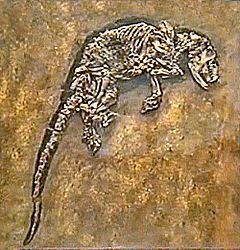Kingdom Animalia Infraclass Eutheria Suborder Pantolesta Phylum Chordata Rank Species | Class Mammalia Superorder Laurasiatheria Family Pantolestidae Genus Buxolestes Order Cimolesta | |
 | ||
Buxolestes minor is an extinct species of semi-aquatic, placental mammals belonging to the family Pantolestidae, part in the first placental evolutionary radiation during the Middle Eocene (50–40 mya).
Description
These otter-like mammals are the smallest in the genus Buxolestes; they are much smaller than most living species of otters, reaching a length of about 30 centimeters. They were fish predators and fossilized stomach contents confirm their semiaquatic habits. The anatomy of these archaic "insectivorous" mammals is known through well-preserved Middle Eocene specimens found at Messel in Germany.
The structure of the neck and lumbar vertebrae as well the vertebrae at the base of the tail evidence a clear adaptation to an active semiaquatic way of life and to a carnivore diet. The forelimbs and hindlimbs are powerful and show strong claws. The tail is clearly fit for swimming. The skull is long, with large molars which appear to be adapted to a diet of molluscs with shells (freshwater clams and freshwater snails), but the predilection postulated by the teeth has not been confirmed. Some authors have interpreted the limb morphology of this species as belonging to a semi-fossorial omnivorous animal, lacking aquatic specialization.
These animals probably were very similar and had similar habits to the common European otters (Lutra lutra) and oriental small-clawed otters (Aonyx cinerea).
